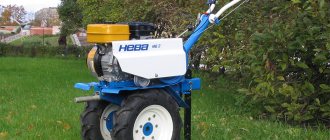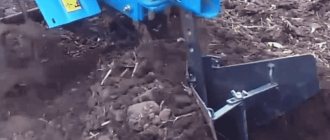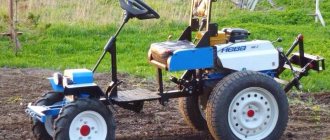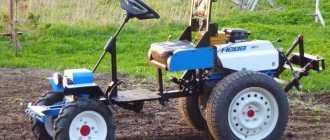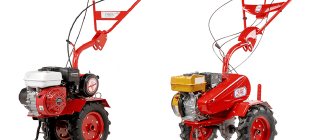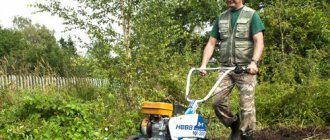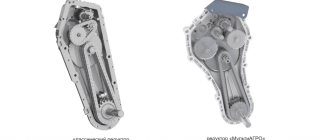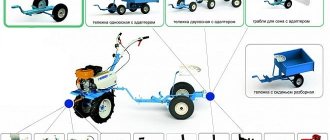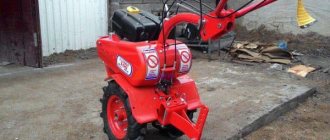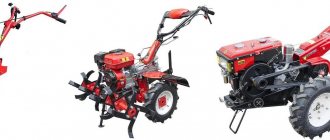is one of the enterprises of the country's military-industrial complex and specializes in the production of such complex and highly loaded equipment as gearboxes and auxiliary equipment for aircraft. Since Soviet times, the plant has been producing equipment for cultivating garden plots - motor cultivators and Neva walk-behind tractors with various configurations of engines and attachments.
Motoblock Neva and attachments for it: expanding the functionality of the unit
Carrying out gardening work such as loosening the soil or mowing the grass by hand can be quite tedious, especially if it is carried out over a large area. Using a unit such as the Neva walk-behind tractor and its attachments will not only make your work much easier, but will also make many processes much more efficient and faster. In addition, it can be easily improved and its functionality significantly expanded. How to choose a walk-behind tractor: characteristics, prices, reviews (read more)
The Neva walk-behind tractor is one of the most popular and reliable units on the modern market.
Gasoline and diesel walk-behind tractors Neva: features, types and advantages
Under the Mototekhnika Neva trademark, a large number of walk-behind tractors are produced, differing in their performance characteristics. You can choose a model that will ideally suit your requirements. Let's look at popular models of walk-behind tractors.
Neva walk-behind tractors can greatly facilitate work on the ground.
MB-Compact - used for processing small areas, characterized by compact dimensions and ease of operation. The MB-Compact engine power is 6.5 hp, and the design of the model allows you to install various attachments on it. The model operates on 2 forward and one reverse gears, which can be switched by simply turning the lever. The support wheel is not included in the basic kit, but you can easily install it yourself.
MB-1 - differs from the previous model in the increased number of gears, there are 3 of them. The unit is designed to work with medium-heavy soils and can be used as a vehicle, as well as for removing snow, leaves and various types of dirt. The engine power for the Neva MB-1 walk-behind tractor is 6.5 hp.
MB-2 – equipped with an engine from the Japanese company Honda with a power of 5.8 hp. The advantage of the Neva walk-behind tractor with a Honda engine is that the number of gears, which is three in the base model, can be doubled by simply rearranging the belt in the engine. You can also install various types of attachments for the Neva MB 2 walk-behind tractor, which will allow you to use it as harvesting equipment. Compared to other models, MB-2 wheels are characterized by an increased diameter, which increases cross-country ability.
The Neva MB-2 walk-behind tractor has high cross-country ability, so it is convenient to use in large areas.
MB-23 is the most powerful model in the line, equipped with a 10 hp engine, which makes it an excellent choice for long and difficult work, including plowing unplowed soil. In addition, the model is highly maneuverable thanks to the wheel release function. This walk-behind tractor model can be converted into a vehicle, as well as attached to a trailer and used as a tractor.
MB-23SD – equipped with a 4.8 hp diesel engine from Subaru. It is characterized by a low arable speed, thanks to which it can effectively cultivate even frozen soil. Just like in other models, the Neva walk-behind tractor with a Subaru engine can be equipped with attachments.
Regardless of the model, all Neva walk-behind tractors are characterized by the following advantages:
- imported engines with high efficiency, allowing for efficient cultivation of the soil;
- the ability to install a variety of attachments and attachments to the Neva walk-behind tractor, significantly expanding its functionality;
- ease of operation and maintenance. To work with a walk-behind tractor, you do not need any special skills; you just need to read the instructions;
- a simple gear shift system, thanks to which you can set the optimal speed for certain types of work.
Motoblocks of the Neva series are widely used for planting potatoes.
On a note! When choosing a walk-behind tractor model, consider the density of the soil you will be working with, as well as the season. Based on these parameters, it is necessary to select engine power and other characteristics.
Optimal models for personal plots and farming
Models for processing 20-80 acres
Let's consider the two most popular models designed for processing 20-80 acres. For such an area, a small power unit is sufficient - up to 6 hp.
Neva MB-2N-5.5
| Specifications | pros | Minuses |
| Engine – petrol, Honda GX-200 Engine power – 5.5 hp. Processing stripe – up to 120 cm Cutter rotation speed – up to 160 rpm Plowing depth – 20 cm Engine capacity – 196 cm³ | The unit folds, which allows it to be transported in the trunk of a car. The central stand is made of a durable round pipe. The number of rotations of the cutter is adjustable. Fuel consumption is 500 grams per hour of operation. The presence of 2 reverse and 4 forward speeds. A spacious tank allows you to work for 6 hours without refueling. | Semi-closed belt drive cover The unit weighs 98 kilograms, considerable physical strength is required to operate it The cooling system malfunctions in the heat Manual engine start |
Neva MB-1B-6.0 FS
| Specifications | pros | Minuses |
| Engine – petrol, Briggs and Stratton Engine power – 4.4 hp. Processing stripe – up to 127 cm Cutter rotation speed – up to 124 rpm Plowing depth – 30 cm Engine capacity – 205 cm³ | The included headlight makes it easier to work at dusk. Starting with an electric starter. Convenient speed switch and tilt adjustment of the steering wheel. Relatively low weight - 75 kg makes it easier to control. Deep immersion of cutters - up to 30 cm, suitable for planting potatoes. Adjustable number of turns of the cutter. | Weak welds that can break due to vibration. You have to cook them from time to time. Wheels will not unlock. |
Professional
Professional units have different power and technical indicators. Let's consider two more popular samples for cultivating 3-4 hectares of land.
Neva MB-23N-9.0 PRO
| Specifications | pros | Minuses |
| Engine – petrol, HONDA Engine power – 9 hp. Processing stripe – up to 168 cm Rotation speed of the cutter – up to 160 rpm Plowing depth – 30 cm Engine capacity – 270 cm³ | The height of the steering wheel is adjustable in three positions. Equipped with universal fasteners for attachments. Large diameter pneumatic wheels make it easier to navigate difficult terrain. The steering wheel frame has additional reinforcement. | High cost Fuel consumption - more than 2 liters per hour Weight over 100 kilograms No electric start Engine cooling - air |
Neva MB-23B-10.0
| Specifications | pros | Minuses |
| Engine – petrol, Briggs and Stratton Engine power – 10 hp. Processing stripe – up to 127 cm Cutter rotation speed – up to 160 rpm Plowing depth – 30 cm | 2 rear and 4 forward speeds Trailer load capacity - up to 700 kg Belt clutch and extra strong frame Axle shafts can be disengaged The gearbox and motor are protected from stones and slipping when in contact with tree roots | Heavy weight - 105 kg High cost Engine cooling - air Fuel consumption - 2.5 liters |
Related article:
The most reliable and popular cultivators and walk-behind tractors. When choosing the right equipment, you should take into account the functionality, manufacturer and cost of the equipment, as well as pay attention to consumer reviews about the purchased product. We will talk about this in the article.
Attachment options for the Neva walk-behind tractor
The basic functions for any version of the walk-behind tractor include preparing the soil for sowing and plowing it. Thanks to the various types of cutters installed on the unit, it is possible to loosen the soil to a depth of several centimeters, but cutters also have disadvantages. They can only handle regularly cultivated soil, but do not cope well with frozen or simply hard soil. In addition, cutters do not allow you to remove debris or snow or use the walk-behind tractor for other purposes. You can solve this problem if you buy attachments for the Neva walk-behind tractor.
The following varieties are distinguished:
- A plow is a good option for additional equipment if you need to work with heavy soil. Weighing 7.8 kg, the P1 20/3 model is capable of plowing even very hard soil to a depth of 215 mm with a working width of 220 mm;
- Hiller is the second most popular equipment option for the Neva walk-behind tractor after the plow. A mounted hiller is used to add soil to the roots of plants. Different models of hillers are distinguished by the depth of entry into the soil and the width of the soil, as well as by weight;
Attachments for the Neva walk-behind tractor - hiller and plow.
- A potato digger is a good choice if you're tired of having to fiddle with a shovel every time you harvest your potatoes. The KNM model is capable of entering the ground to a depth of 220 mm, while capturing 250 mm in width. This option will be very useful if you need to process a large area of a potato field as efficiently as possible, quickly and without much effort in terms of effort. Models of potato diggers are distinguished by weight, width of soil coverage and depth of penetration into the soil. Please note that to install this and other equipment described above on a walk-behind tractor, you will need special couplings, individual for each model;
- lugs - are installed as the wheels of a walk-behind tractor and are used to drive the unit deeper into the ground. They vary in diameter, width and weight, and can be used for hilling an area;
- cart or trailer - equipment designed to transform a walk-behind tractor into a transport vehicle. The dimensions of the trailer are selected depending on the engine power of the unit, and the maximum speed at which a walk-behind tractor with a trolley can move usually does not exceed 10 km/h;
- mower – allows you to use a walk-behind tractor for mowing the lawn or cutting grass for animal feed. Different mower options differ in the maximum height of grass cut, operating speed and coverage width;
The potato digger and lugs can be selected according to size, weight and plowing depth.
- potato planter - special equipment that is suitable for all types of walk-behind tractors and greatly facilitates the process of planting potatoes;
- reversible plow - characterized by a large soil coverage, due to which there are no missed areas when plowing. When installing this equipment option, it should be taken into account that it requires a counterweight. If the walk-behind tractor model weighs less than 100 kg, then it is recommended to install a weighting agent on it;
- rake - equipment for removing leaves and various debris from the site. You can buy such a spare part for the Neva MB 2 walk-behind tractor and other models or make it yourself, provided you have a welding machine;
- snow removal equipment - makes the Neva walk-behind tractor useful in the cold season. There are several options for snow blowers for the Neva walk-behind tractor, each of which performs its own functions.
Special equipment that facilitates excavation work is a reversible plow and a potato planter.
On a note! When purchasing any type of attachment for the Neva walk-behind tractor, make sure that it is suitable for the specific model of the unit, and also take care in advance of purchasing all the necessary fasteners and couplings.
Design and principle of operation
The design of the Neva walk-behind tractors is classical.
The main components include the following:
- candles;
- hub;
- water pump;
- air filter;
- generator;
- tension roller;
- throttle handle, engine;
- gearbox;
- wheels;
- pump;
- starter;
- frame;
- clutch cable;
- axle extensions;
- starter.
This is approximately what the detailed design diagram of the described walk-behind tractors looks like.
Often, to make the structure heavier, a load is additionally used, through which the cutters are better immersed in the ground, thereby ensuring high-quality operation of the equipment. The shaft diameter in modern models is on average 19 mm.
The design of the device may vary depending on the needs of the user, in this case we are talking about the use of attachments. Gardeners and gardeners most often use a walk-behind tractor when preparing a plot of land for planting.
This is an effective tool that helps perform many agricultural tasks. Its tines can go deep into the soil to extract weed roots. Walk-behind tractors are equipped with pneumatic wheels that help guide the device during use.
Gear wheels, or lugs, are used for cultivation, and pneumatic wheels are used for transportation along the highway . The lugs are oriented parallel to each other in a metal frame, usually made of steel.
Snow blowers for the Neva walk-behind tractor: types and features
There are such options for snow blowers for the Neva MB 2 walk-behind tractor and other models, such as canopy, blade and brush. The canopy allows you to simulate the operation of a snow blower and remove even stale snow. The blade differs from it in that it allows you to remove a smaller layer of snow over a width of about 1 meter, while the canopy covers approximately 60 cm. The rotary brush is designed for removing freshly fallen snow that has not yet compacted. The only significant drawback of the rotary brush is its heavy weight, so be prepared to reduce the maneuverability of the unit when installing it.
The Neva walk-behind tractor, thanks to its attachments for snow removal, is effective even in winter.
Neva MB is your indispensable assistant
Working on the land is not easy work. For those who are tired of manually digging up beds and hilling potatoes, the Neva 2 walk-behind tractor is perfect. And the reason for this is its versatility and wide range of applications. The use of attachments and trailed equipment designed specifically for the Neva walk-behind tractor makes it possible to perform the following types of work:
- plowing, harrowing, soil cultivation;
- weeding and hilling beds;
- planting and harvesting potatoes;
- transportation of agricultural implements, harvested crops, and other cargo using a special trailer;
- preparing feed for domestic animals using a rotary mower;
- mechanization of work on removing snow, fallen leaves, and sediment;
- with a connected water pump, the Neva 2 walk-behind tractor will be able to provide the area with water for irrigation.
Before purchasing a walk-behind tractor, you must determine the purpose of its purchase and the size of the areas to be processed. To carry out agricultural work in small areas with light soils, there is no point in buying a powerful walk-behind tractor, given that its cost and fuel consumption directly depend on this.
Do-it-yourself snow removal attachments for walk-behind tractors
The disadvantage of all options for winter attachments is the rather high cost of snow blowers for Neva walk-behind tractors. Not everyone can afford to buy such equipment, but this problem can be overcome if you have the necessary skills and tools.
The simplest version of a homemade snow blower for the Neva MB 2 walk-behind tractor and other models is a bulldozer-type blade. To create it, you will need a special adapter that is attached to the unit and a metal sheet with a pointed edge that will act as a snow blade. All parts of the structure are cut out of steel and connected to each other using rods and brackets.
The second, slightly more complex option is a rotary nozzle. It is made from a pipe into which snow is thrown, a box, a gearbox, a shaft and an auger. To make such a nozzle, you will need a welding machine, as well as detailed instructions, which can be found in large quantities on the Internet.
You can make snow removal attachments yourself or purchase them in specialized stores.
The third type of snow removal equipment for the Neva walk-behind tractor is a snow thrower that operates on the principle of a fan. This design is quite complex, so it is recommended to find instructions or a video to create it. Neva walk-behind tractors with a fan attachment are designed to work with soft, not yet compacted snow.
The most complex version of the snow removal attachment that you can make with your own hands is the auger-fan one. It works well on packed and icy snow and can cover a large area, but you will need specialized knowledge and tools to make it.
Neva walk-behind tractor with caterpillar drive
Although Neva walk-behind tractors are equipped with wheels as standard, you can buy a tracked attachment for your unit. Neva crawler walk-behind tractors differ from their wheeled counterparts in their increased maneuverability in rainy or snowy weather and allow the unit to be used at any time of the year. You can buy tracks for Neva walk-behind tractors, or you can make them yourself using improvised means.
Neva walk-behind tractors with a caterpillar drive have high maneuverability and can be used in adverse weather conditions.
Making tracks for a walk-behind tractor with your own hands
If you don’t want to buy a caterpillar drive for Neva walk-behind tractors, but make it yourself, then for this you will need the following materials:
- the walk-behind tractor itself, equipped with an axle locking function and a 4-stroke engine;
- transport tape or a pair of large-diameter car tires for making tracks;
- a pair of extra wheels.
The simplest version of tracks for the Neva walk-behind tractor, reviews of which indicate the high efficiency of the design, is a design made from a transport belt. To make it, you will need a tape with a thickness of at least 7 mm, as well as an additional wheel on each side of the unit. To make the tape track last longer, you can stitch it along the edge with thick fishing line.
On a note! Additional wheels for a crawler walk-behind tractor can be taken from an old car. The main thing is that they exactly match the original wheels in diameter.
To make tracks with your own hands, it is better to use old car tires.
Also, a tracked unit from a Neva walk-behind tractor with an American or Japanese engine can be made using car tires. For this you will need tires with a large diameter and the correct tread pattern. It is best to choose tires from a tractor or large truck for this.
The process of making tracks from tires is divided into the following stages:
- Cutting tracks for tracks in tires. To do this, you can use a special shoe knife, which must be moistened with a soap solution to facilitate the process of cutting rubber.
- Cutting off the side part from them. This can be done with a fine-toothed jigsaw.
- Removing excess parts from the inside of the tire.
The advantage of tracks made from car tires is their increased strength and reliability due to their solid structure. The disadvantage follows from the advantage and is that the length of such a track is strictly limited by the length of the tire.
In addition, tracks for walk-behind tractors can be made from belts or chains. In the first case, it is necessary to connect several belts with a wedge-shaped profile to each other. The connection is made using lugs and rivets. For the second option you will need two chains of the same size.
When installing tracks on a walk-behind tractor, use a water-cooled engine.
Before making tracks for the Neva unit, you need to correctly calculate their parameters. If the caterpillar is too high, the walk-behind tractor may tip over when turning. In addition, when installing tracks, it is better to choose a water-cooled engine model, since this design puts a greater load on the engine and can lead to overheating.
Hillers used in canopies for walk-behind tractors
The most labor-intensive work is cutting furrows for planting and hilling up grown plants. A hoe in the hands of a gardener is a universal tool. The hiller for the Neva walk-behind tractor was created before other mounted implements. The difference between a disk and a plowshare hiller used in a canopy lies in the principle of their operation. The hiller, created from shaped parts connected to each other as an arrow, allows you to spread the soil on both sides with a sharp end with an oval through a curved profile. The devices are distinguished:
- unregulated;
- adjustable;
- Dutch.
A non-adjustable hiller is a design with a fixed working width. This is the simplest device that creates a uniform camber during operation due to the fixed wings. Such a hiller can work on furrows where the planting was carried out taking into account its profile. This tool works in furrows up to 30 cm wide and is not capable of hilling rows of potatoes. They use sheds with light cultivators on rods up to 12 mm thick. The device is energy-intensive due to its profile and is used on moderately moist soil. Its use on a powerful walk-behind tractor is unjustified.
Hillers with variable grip are the most common tool on personal farmsteads, since the principle of its operation resembles a hoe. This tool can be adjusted to fit any row spacing. A double hiller is also used. When passing, part of the soil is rolled back into the furrow, making the ridge lower. However, not only the camber is regulated, but also the hilling depth.
The Dutch type hiller is a compromise between the first and second options. The height of the stroke and the narrow furrow are obtained by raising the flaps to the desired height. When folded they are almost double. They rise up like the wings of scoop butterflies. Due to the high wing, the earth does not fall into the furrow, the ridge is high.
For the Neva walk-behind tractor, the disc hiller is considered the best canopy. Two disks installed at a certain distance are set at the desired angle of escape. The fastening system is adjusted to form the required row size and stroke height. Such devices cost several times more than winged ones, but they work more efficiently and place less load on the walk-behind tractor.
When working with a hiller, you should use a reduced speed and replace rubber wheels with metal ones for better traction with the soil. After work, clean all fastening parts from the soil and lubricate them with thick lubricant - lithol or grease.
Features of the Neva MB-23S-9.0 walk-behind tractor with a 9 hp Subaru EX27 engine: video of use
Among all engine options for walk-behind tractors Neva, Subaru 9 hp. is the heaviest and most powerful. A model with such an engine is perfect for solving a wide range of tasks and can be used regardless of the time of year.
A distinctive feature of the engine for the Neva Subaru walk-behind tractor with 9 horsepower is the ability to use any type of attachment. In addition, the MB-23 model is characterized by a reinforced gearbox design, on which an additional cutter can be installed on each side. This allows you to simultaneously cultivate a plot of land up to 170 cm wide.
There are also several other reasons for purchasing such a model. If you decide to buy a Neva Subaru EX27 walk-behind tractor, you will save significantly on fuel for the unit. A special balancing device effectively suppresses vibrations and reduces noise during operation. The model starts up equally easily both at above-zero temperatures and in cold weather.
Using a potato digger with a walk-behind tractor
The operating principle of potato harvesting equipment is based on removing tubers from the ground and sifting. Harvesting is done manually. For each pass of the walk-behind tractor, potatoes are removed from one row.
Potato digger for the Neva walk-behind tractor of the KKM-1 vibration type is used on light, dry soils with low humidity. At the same time, there should be less stones in the ground than 9 t/ha. The device consists of a plowshare and a grid on which the soil is separated and the potatoes remain on the surface. The device is single-row, with a productivity of up to 0.2 ha/hour. A strip 37 cm wide and 20 cm deep is grabbed, trimmed and passed through the grate. There are other modifications based on the same principle of vibration screening of the cut stroke.
A vibration device called Poltava has a similar effect. The potato digger has a larger grip, but a smaller recess. The device is designed to work in soil with average humidity and composition.
Neva walk-behind tractors with 7.5 hp Subaru engine: reviews from owners and features of the units
Subaru engines with a power of 7.5 horsepower are installed on Neva MB 2 walk-behind tractors. The price of such a device is slightly higher than that of the standard MB-2 model, but the performance characteristics are also higher. The model is equipped with a four-stroke Japanese engine, which allows it to perform a wide range of work, as well as use the unit as a vehicle or transportation vehicle. The engine of the Neva Subaru 7.5 hp walk-behind tractor maintains stable speed at any air temperature, which makes it equally effective for use in winter and summer.
Neva 7.5 hp walk-behind tractors with a Subaru engine can be used for cutting grass, digging up potatoes, removing debris from the site, loosening the soil and many other purposes. Reviews from owners speak of the high power and maneuverability of the device, as well as ease of operation and management. And if you need to expand the functionality of the unit using attachments, then this can easily be done on your own.
On a note! When using a Neva walk-behind tractor with a 7.5 hp Subaru engine, make sure that the weight of additional equipment does not outweigh the unit itself. If this does happen, use weights.
The Subaru 7.5 hp engine is efficient to use at any time of the year.
Homemade tractor from a Neva walk-behind tractor: reviews from owners and manufacturing instructions
The main disadvantage of any model of walk-behind tractor is that you need to walk to use it. When processing large areas, this quickly leads to fatigue. You can get rid of this problem if you make a mini version of the tractor from the Neva walk-behind tractor with your own hands. Videos of this process can be found in large quantities on the Internet, so there should be no problems with improving the design.
Of course, an additional module for seated control can be purchased. However, it is much more economical to do it yourself. The homemade design includes a conventional frame made of rolled metal with attached wheels and a seat.
To make this design you will need the following components:
- Rolled metal for the frame - a metal corner, tee or half-tee, as well as a square or channel are suitable for these purposes.
- A pair of wheels with a solid axle or two axle axles.
- Welding machine and consumables for welding work.
- Bearings and fastenings.
- Sitting.
- Lubricants and paints and varnishes.
You can create a convenient mini-tractor based on any walk-behind tractor.
In addition, the following tools will be useful to you:
- grinder or other tool for cutting metal;
- plumbing tools such as screwdrivers, hammer, chisel, wrenches or adjustable wrenches;
- dies and taps for marking cut metal products;
- electric drill and drill set;
- brushes and rollers for applying lubricants and paint.
When manufacturing a tractor from a walk-behind tractor, the kinematic diagram is first designed. It is designed to ensure that the resulting structure maintains balance and does not overload the walk-behind tractor. After this, the frame is made from rolled metal. At this stage it is very important to consider the location of the fork and bushing for turning the trailer. After this, you can begin manufacturing the body. The best material option for it is steel sheet.
After creating the frame and body, the driver's seat and attachments, if necessary, are attached to the resulting structure. Upon completion of the installation work, you can begin painting the finished mini-tractor.
The mini-tractor is convenient to use for harvesting large areas.
Reviews from owners of home-made units indicate that you can create a mini-tractor based on any walk-behind tractor, and it will cost much less than buying it. Neva walk-behind tractors with a Subaru engine, for example, can be converted into a miniature tractor with minimal investment of money and time.
On a note! Transforming the Neva walk-behind tractor into a mini-tractor will help you solve the problem of insufficient weight of the unit. The trailer and the driver weigh the block so much that the traction of its wheels with the ground is significantly improved. This, in turn, increases maneuverability and efficiency of land cultivation.
Motoblock Neva and attachments for it: care and safety precautions
No matter what model of walk-behind tractor you use, it needs regular maintenance and repair to ensure maximum longevity. First of all, the engine of the unit needs regular diagnostics and cleaning. The part that wears out the most quickly here is the air filter. It must be cleaned after every 25 hours of use of the walk-behind tractor, and the cartridge in it must be changed every 100 hours. If work is carried out in particularly dusty conditions, then this must be done more often.
The Neva walk-behind tractor is easy to use, but requires regular maintenance.
The motor cooling fins and the mesh at the inlet of the air cooling fan also need regular cleaning. Before cleaning them, the walk-behind tractor must be turned off. In addition, check the oil level every day and completely change it every 25 hours of operation. Replacement must be carried out when the engine is warm.
Before working with a walk-behind tractor, make sure that you know the purpose of all its controls, adjust the height of the steering handles to your height, and disconnect the power drive from the engine. Carefully monitor the condition of the mechanism's wheels; low pressure in them can lead to slipping and a significant reduction in the maneuverability and efficiency of the unit.
If you own a large plot of land, then you should definitely buy a Neva walk-behind tractor. Prices for various models of this unit are relatively low, and the difference between using a walk-behind tractor and manual labor will be felt immediately.
How to use in winter?
Modern walk-behind tractors can be used in winter as equipment that helps quickly clear an area of snow. First of all, you need to know that any driving on chains is the only sure way to operate the equipment without problems. Put chains on pneumatic wheels. Thus, a kind of winter tires are obtained.
Before starting the walk-behind tractor, you will first need to determine which cooling system is in the design. If it is air, then there is no need for antifreeze, but it is worth remembering that the engine will heat up faster and cool down just as quickly, so it is not recommended to take long intervals between work.
Some models will require additional insulation to be able to operate the equipment in cold conditions. You can use either a branded cover or a blanket or blanket. Additional insulation will be required only if the temperature drops below -10 degrees .
Particular attention to the type and quality of oil that you plan to use. It is best to take synthetic ones , since they retain their properties better. It is advisable to look at the texture, it should be liquid, otherwise the product will quickly thicken.
When starting up for the first time, the walk-behind tractor should run for fifteen minutes at idle speed.
Winter storage, or as it is also called, preservation, should be carried out in accordance with the manufacturer’s recommendations.
- The oil must be completely changed. If you can’t buy it, you can filter out the old one, but in a high-quality manner so that there are no impurities.
- All existing filters will also need to be changed. If they are in an oil bath, then fresh product should be used.
- Experienced users advise unscrewing the spark plugs, pouring a little oil into the cylinder, then turning the crankshaft by hand.
- When actively using the walk-behind tractor, it will definitely need to be cleaned of dirt, including even those elements that are located in hard-to-reach places. Lubricant is applied to the body and components; it will help protect the equipment from corrosion during storage.
- Electrical connectors will need to be lubricated with specialized silicone grease, which is also applied to the spark plug caps, protecting them from negative environmental influences.
- In models of any walk-behind tractor that have an electric starter, the battery will need to be removed and stored in a dry room for winter storage. During the time it is stored, it can be charged several times.
To prevent the rings from falling into the cylinders, it is necessary to pull the starter handle several times with the fuel supply valve open.
You will learn how to assemble and launch the Neva walk-behind tractor in the video below.
